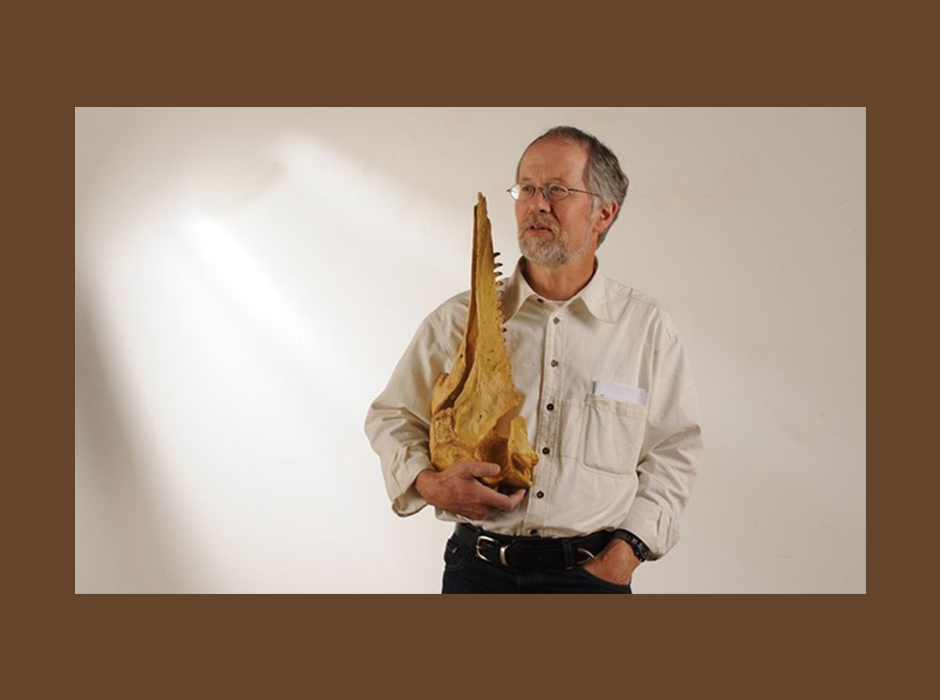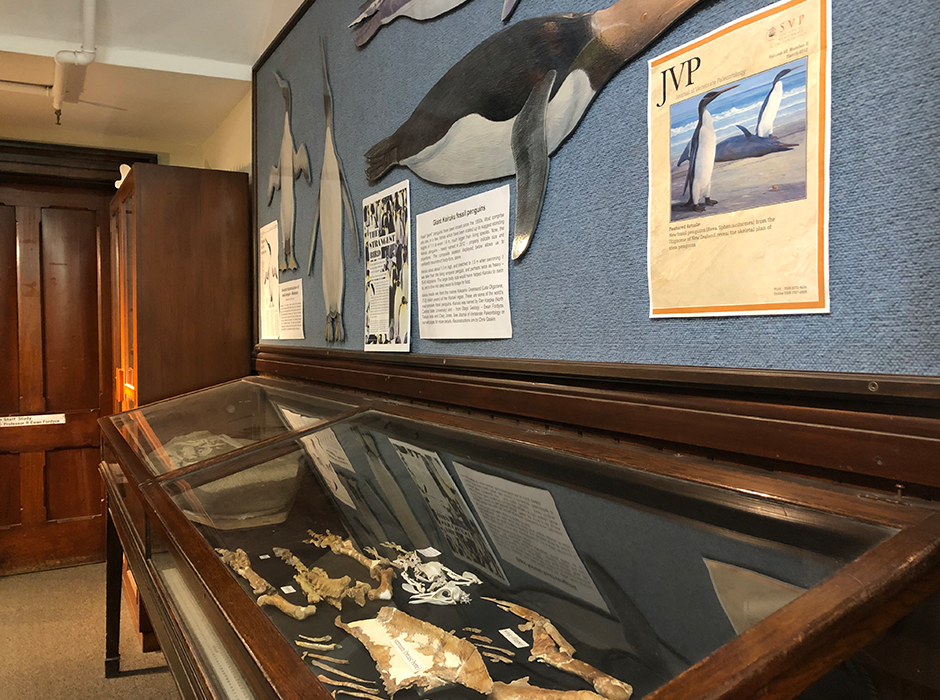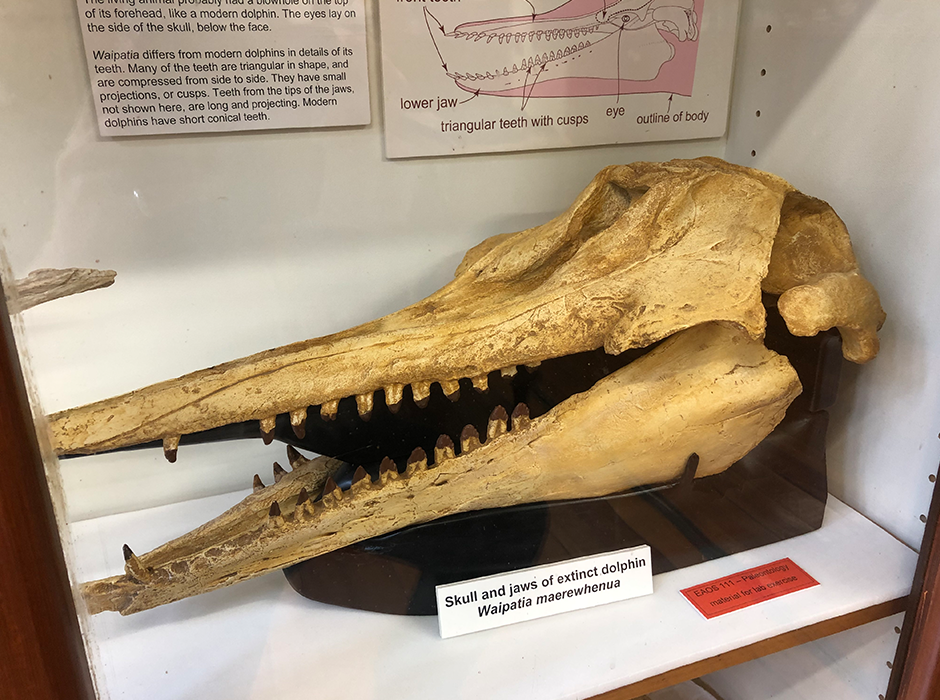
Emeritus Professor R. Ewan Fordyce’s (FRSNZ)
The life and work of Emeritus Professor R. Ewan Fordyce’s (FRSNZ), who recently passed away, has left a huge legacy for his field of paleontological research and his 40-year association with the Department of Geology.
As the face of vertebrate paleontology in New Zealand and further afield over the past decades, the life and career of Professor Fordyce was one of a close connection to the fascinating evolution of the natural world. It was a connection established at an early age and as a teenager he assisted university students to analyse fossils through the Canterbury Museum's Junior Club.
“I was pretty fascinated by animals, fossil and modern, and I could see what they were doing, and what they were looking for,” Professor Fordyce recalled for a story on his retirement from Otago early in 2022. “I thought, 'I can do this', so I went out on my own in weekends and collected specimens I knew they could use.”
Studying for his own undergraduate and doctorate degrees at the University of Canterbury, Professor Fordyce’s first significant discovery took place in a riverbed in South Canterbury. It took five years before the fossil was identified as a giant penguin that stood around 1.3 metres tall. Named Kairuku (meaning ‘the diver that returns with food’), the fossil remains on display in the Department of Geology Museum.
Prior to arriving at the University of Otago in 1982 and following his PhD, Professor Fordyce held postdoctoral positions at the Smithsonian Institution, Washington D.C. and at Melbourne’s Monash University. Over the course of his 40 years in Otago’s Department of Geology a distinguished and well-recognised career flourished.
Professor Fordyce was simply a research powerhouse. His paleontological field and lab investigations led to more than 200 publications, most of which addressed the paleontology, morphology, taxonomy, systematics, and phylogeny of Cetacea (whales, dolphins and porpoises). His prolific output continued through until retirement as he worked on a 2019 Marsden Fund-project investigating field sites for whales and dolphins from 18-20 million years ago.
Recognising Professor Fordyce’s enormous contributions to marine vertebrate paleontology, several fossil species have been named fordycei. The most recent, Kumimanu fordycei, a species of the world’s largest penguin, was named earlier this year. Thousands of fossils that he collected over the decades are now archived in the Department of Geology with many on display in Otago’s Geology Museum.

On display outside the door to Professor Fordyce’s office, giant Kairuku fossil penguins collected from the marine Kokoamu Greensand (27-28 million years) of the Waitaki region.
Long-time colleague and collaborator in the Department of Geology Honorary Professor Daphne Lee, worked with Professor Fordyce for more than three decades and describes him as a remarkable teacher to generations of paleontology, sedimentology and stratigraphy students.
“Ewan’s lecture notes were meticulous, his labs well-organised and his enthusiasm contagious. Dozens, or perhaps hundreds, of students who arrived to do a single first-year geology paper continued in paleontology and paleoecology because of his influence,” Professor Lee says.
“Thanks in large part to Ewan’s contribution, over the last 40 years Otago has had by far the most thriving and productive teaching and research programme in paleontology in New Zealand and arguably in Australasia. His legacy as a teacher, researcher, role model, mentor, supervisor, editor and photographer will continue to inspire future generations of students and researchers from all around the world.”
Well known for his engaging teaching approach and natural connection with those he worked with, Professor Fordyce’s research career involved the supervision of around 50 PhD and postgraduate students. In addition to his many collaborations with a wide network of colleagues, he trained many of New Zealand's palaeontology researchers and his expertise is recognised globally.
Head of the Department of Geology, Associate Professor Andrew Gorman says that Professor Fordyce’s world class research and fossil collections are an absolute legacy for his colleagues and students.
“His work will continue on in the scientists whom he trained and through the substantial collections of fossil material yet to be fully evaluated,” Associate Professor Gorman says.
In recognition of the output of his sustained and high-quality research, Professor Fordyce received numerous accolades over his career including the 2019 McKay Hammer, the premiere award of the Geoscience Society of New Zealand. In the same year he received the Riversleigh Medal in palaeontology for excellence in promoting understanding of Australasian prehistory.
Professor Fordyce was elected as a fellow of the Royal Society of New Zealand in 2014, and in addition to a period of five years as the Head of Department of Geology at Otago, he was promoted to Professor in 2011.
Division of Sciences Pro-Vice-Chancellor Professor Richard Barker says that in addition to his enormous contribution to research, that Professor Fordyce was also instrumental in incorporating palaeontology into the geology curriculum at all levels.
“He was also a great supporter of the wide range of subdisciplines in the department and as a new member myself of the Sciences head of department group in 2008, Professor Fordyce’s wise and considered contributions to leadership made a lasting impression on me,” Professor Barker says.

Displayed in the Geology Museum, the fossil skull and jaws of Waipatia were found in the Otekaike Limestone near Duntroon, and formally named in 1994.
Early in his career, an award Professor Fordyce received in 1987 that he was particularly proud of was the Antarctic Service Medal from the US Department of the Navy. In that year he joined a US expedition and discovered a fossilised skull and partial skeleton of a whale on Seymour Island, off the east coast of the Antarctic Peninsula.
The discovery proved to be momentous as it matched an earlier discovery of part of a jaw of the same whale found by American researchers in the mid-1970s. It was shipped back to the Geology Department, and due to the highly technical processes required, the fossil took the equivalent of three years of full-time work, spread over decades, to prepare. The fossil, Llanocetus denticrenatus, was identified as a 34 million-year-old baleen whale and represented a major piece in the evolutionary jigsaw of early whales.
The fossil has been the subject of many papers, including one published in 2018 stating that even though Llanocetus denticrenatus is an ancient relative of modern whales like humpback and blue whales, a key difference was its well-developed teeth, a significant contribution to advancing the body of evolutionary knowledge.
In 2022, the Geology Department signed a deed of gift with the Smithsonian National Museum of Natural History, for the skull and partial skeleton of Llanocetus denticrenatus to be shipped to the Smithsonian and reunited with the original jaw fragment for display.
Closer to home, it was local fossil sites such as those of North Otago that were the places of Professor Fordyce’s passion for research, teaching, and outreach. Since 2000, he was actively involved with communicating fossil-related science which led to the development of the community-supported Vanished World Trail and Vanished World Centre in Duntroon.
He was also instrumental in promoting Vanished World to UNESCO Geopark status, a long and detailed process that culminated in the formal recognition of the UNESCO Waitaki Whitestone Geopark in June this year, the first of its type in New Zealand.
Reaching this milestone was a special moment for Professor Fordyce, who travelled to Waitaki to join the official celebrations. It was the result of 20 years of working with the local community to showcase the region’s unique geological wonders to the world.
Professor Fordyce’s reputation and respect was highly regarded internationally. The volume presented to Professor Fordyce following his retirement in 2022 (R. Ewan Fordyce: Tributes from a Global Community) said it all, Professor Lee notes. “In the volume’s 92 pages, contributions from more than 60 people based in 15 countries show in what esteem Ewan, the Geology Department and our fossil collections are held around the world.”
Connecting the dots and furthering our understanding of our natural history evolution was what Professor Fordyce cared for, what he excelled at, and what he has left in his wake for others to pick up where he’s signed off.
Ewan is survived by his wife Marilyn, son Robbie and daughter Anna.
Kōrero by Guy Frederick, Sciences Communications Adviser